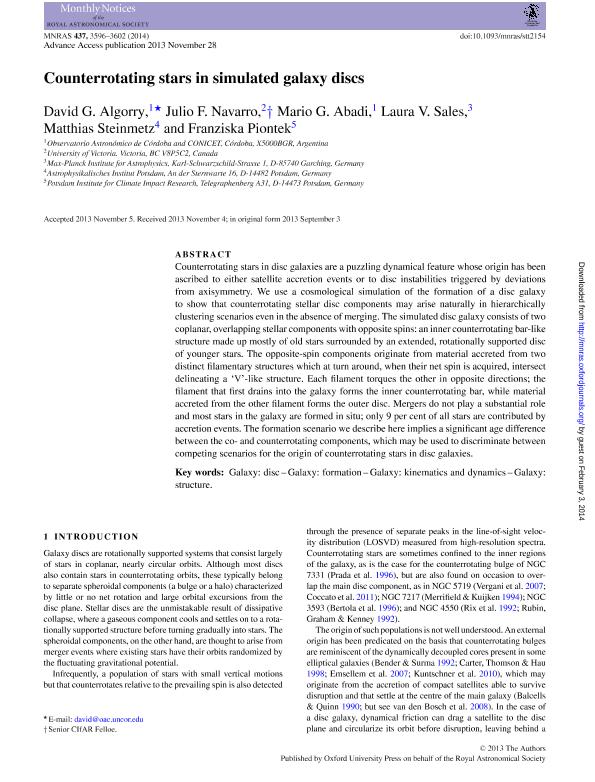Mostrar el registro sencillo del ítem
dc.contributor.author
Algorry, David Gabriel

dc.contributor.author
Navarro, Julio F.

dc.contributor.author
Abadi, Mario Gabriel

dc.contributor.author
Sales, Laura Virginia

dc.contributor.author
Steinmetz, Matthias
dc.contributor.author
Piontek, Franziska
dc.date.available
2018-01-04T20:47:59Z
dc.date.issued
2013-11
dc.identifier.citation
Piontek, Franziska; Steinmetz, Matthias; Sales, Laura Virginia; Abadi, Mario Gabriel; Navarro, Julio F.; Algorry, David Gabriel; et al.; Counterrotating stars in simulated galaxy discs
; Oxford University Press; Monthly Notices of the Royal Astronomical Society; 437; 4; 11-2013; 3596-3602
dc.identifier.issn
0035-8711
dc.identifier.uri
http://hdl.handle.net/11336/32363
dc.description.abstract
Counterrotating stars in disc galaxies are a puzzling dynamical feature whose origin has been ascribed to either satellite accretion events or to disc instabilities triggered by deviations from axisymmetry. We use a cosmological simulation of the formation of a disc galaxy to show that counterrotating stellar disc components may arise naturally in hierarchically clustering scenarios even in the absence of merging. The simulated disc galaxy consists of two coplanar, overlapping stellar components with opposite spins: an inner counterrotating bar-like structure made up mostly of old stars surrounded by an extended, rotationally supported disc of younger stars. The opposite-spin components originate from material accreted from two distinct filamentary structures which at turn around, when their net spin is acquired, intersect delineating a ‘V’-like structure. Each filament torques the other in opposite directions; the filament that first drains into the galaxy forms the inner counterrotating bar, while material accreted from the other filament forms the outer disc. Mergers do not play a substantial role and most stars in the galaxy are formed in situ; only 9 per cent of all stars are contributed by accretion events. The formation scenario we describe here implies a significant age difference between the co- and counterrotating components, which may be used to discriminate between competing scenarios for the origin of counterrotating stars in disc galaxies.
dc.format
application/pdf
dc.language.iso
eng
dc.publisher
Oxford University Press

dc.rights
info:eu-repo/semantics/openAccess
dc.rights.uri
https://creativecommons.org/licenses/by-nc-sa/2.5/ar/
dc.subject
Galaxy
dc.subject
Formation
dc.subject
Discs
dc.subject
Dynamics
dc.subject.classification
Astronomía

dc.subject.classification
Ciencias Físicas

dc.subject.classification
CIENCIAS NATURALES Y EXACTAS

dc.title
Counterrotating stars in simulated galaxy discs
dc.type
info:eu-repo/semantics/article
dc.type
info:ar-repo/semantics/artículo
dc.type
info:eu-repo/semantics/publishedVersion
dc.date.updated
2018-01-03T20:10:16Z
dc.journal.volume
437
dc.journal.number
4
dc.journal.pagination
3596-3602
dc.journal.pais
Reino Unido

dc.journal.ciudad
Oxford
dc.description.fil
Fil: Algorry, David Gabriel. Universidad Nacional de Cordoba. Observatorio Astronomico de Cordoba; Argentina. Consejo Nacional de Investigaciones Científicas y Técnicas; Argentina
dc.description.fil
Fil: Navarro, Julio F.. University Of Victoria; Canadá
dc.description.fil
Fil: Abadi, Mario Gabriel. Universidad Nacional de Cordoba. Observatorio Astronomico de Cordoba; Argentina. Consejo Nacional de Investigaciones Científicas y Técnicas; Argentina
dc.description.fil
Fil: Sales, Laura Virginia. Gobierno de la Republica Federal de Alemania. Max Planck Institut Fur Astrophysik; Alemania. Consejo Nacional de Investigaciones Científicas y Técnicas; Argentina
dc.description.fil
Fil: Steinmetz, Matthias. Astrophysikalisches Institut Potsdam; Alemania
dc.description.fil
Fil: Piontek, Franziska. Potsdam Institute for Climate Impact Research; Alemania
dc.journal.title
Monthly Notices of the Royal Astronomical Society

dc.relation.alternativeid
info:eu-repo/semantics/altIdentifier/doi/http://dx.doi.org/10.1093/mnras/stt2154
dc.relation.alternativeid
info:eu-repo/semantics/altIdentifier/url/https://academic.oup.com/mnras/article/437/4/3596/1007545
Archivos asociados
